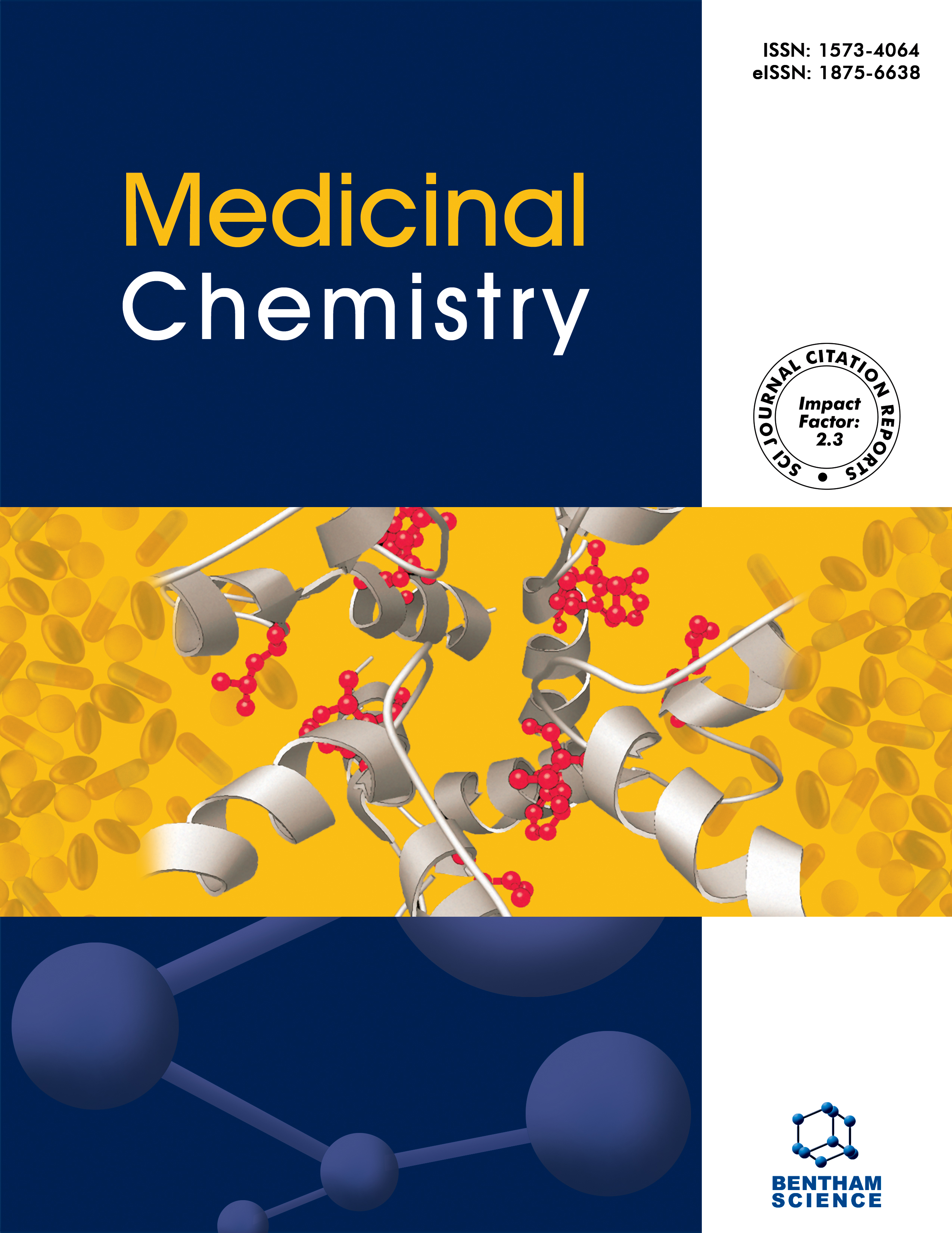- Home
- A-Z Publications
- Medicinal Chemistry
- Previous Issues
- Volume 13, Issue 5, 2017
Medicinal Chemistry - Volume 13, Issue 5, 2017
Volume 13, Issue 5, 2017
-
-
Medicinal Chemistry Approaches of Controlling Gastrointestinal Side Effects of Non-Steroidal Anti-Inflammatory Drugs. Endogenous Protective Mechanisms and Drug Design
More LessAuthors: Paraskevi Tziona, Panagiotis Theodosis-Nobelos and Eleni A. RekkaBackground: Non-steroidal anti-inflammatory drugs are the oldest and most widely used medicines. However, their untoward effects, especially gastrointestinal toxicity, remain the main obstacle to their application. Because of their mechanism of action, cycloxygenase (COX) inhibition, in combination with the weekly acidic character of most of them, major protective mechanisms of the gastrointestinal system are suppres Read More
-
-
-
Effect of Inhibition of Intestinal Cholesterol Absorption on the Prevention of Cholesterol Gallstone Formation
More LessAuthors: Piero Portincasa and David Q.-H. WangBackground: Cholesterol cholelithiasis is a multifactorial hepatobiliary disease. Methods: Interactions between genetic and environmental factors play a critical role in biliary cholesterol homeostasis and its imbalance enhances cholelithogenesis. Results: In patients developing symptoms or complications of gallstone disease, laparoscopic cholecystectomy is recommended for treatment of gallstones. In a subgroup of patient Read More
-
-
-
Naphthyridines with Antiviral Activity - A Review
More LessAuthors: Inder P. Singh, Sanjay Kumar and Shiv GuptaBackground: Naphthyridine scaffold is an important pharmacophore in compounds which have shown various biological activities like antiviral, antimicrobial, anticancer, antiinflammatory and analgesic. This scaffold is also reported to exhibit activity against HIV, HCMV, HSV, HPV and HCV. Antiviral activity displayed by many naphthyridine analogs is in nM range. Only few review articles are available in literature which descri Read More
-
-
-
Synthesis and Biological Evaluation of Hybrid 1,5- and 2,5-Disubstituted Indoles as Potentially New Antitubercular Agents
More LessBackground: Tuberculosis (TB) is the second leading cause of mortality worldwide being a highly contagious and insidious illness caused by Mycobacterium tuberculosis, Mtb. Additionally, the emergence of multidrug-resistant and extensively drug-resistant strains of Mtb, together with significant levels of co-infection with HIV and TB (HIV/TB) make the search for new antitubercular drugs urgent and challenging. Method Read More
-
-
-
Microwave-assisted Synthesis of 2-Styrylquinoline-4-carboxylic Acids as Antitubercular Agents
More LessAuthors: Gisela C. Muscia, Silvia E. Asis and Graciela Y. BuldainBackground: Many 2-substituted quinolines and especially 2-arylvinyl derivatives isolated from plants or prepared by synthesis have been designed from ethnopharmacological studies. Objective: In order to explore new aspects of the structure-antituberculosis activity relationship, a series of styrylquinoline derivatives was prepared. Method: A series of styrylquinoline derivatives was prepared from quinaldic acid and a variety Read More
-
-
-
Synthesis and Ativiral Activity of 5-(Benzylthio)-4-carbamyl-1,2,3-triazoles Against Human Cytomegalovirus (CMV) and Varicella-zoster Virus (VZV)
More LessBackground: All of the clinical drugs for herpesvirus infections exhibit high toxicity and suffer from significant drug-resistantance. There is a great need for the development of new, effective, and safe anti-herpesvirus agents with different mechanisms of action. Methods: A series of novel 5-(benzylthio)-1H-1,2,3-triazole-4-carboxamides were efficiently synthesized and EC50 values against human cytomegalovirus (HCMV), var Read More
-
-
-
Harmaline and its Derivatives Against the Infectious Multi-Drug Resistant Escherichia coli
More LessAuthors: Hina Siddiqui, Sehar Tasneem, Saba Farooq, Amtul Sami, Atta-Ur-Rahman and Muhammad I. ChoudharyBackground: Multidrug resistance (MDR) is a major challenge in the treatment of infectious diseases. The MDR in urinary tract infection causing bacteria, such as Escherichia coli, has made treatment of UTI very difficult. Objective: The aims of the current study were to synthesize a library of harmaline derivatives, and to evaluate their activity against various strains of multi-drug resistance (MDR) E. coli. Method: Harmaline der Read More
-
-
-
The Impact of DIDS-Induced Inhibition of Voltage-Dependent Anion Channels (VDAC) on Cellular Response of Lymphoblastoid Cells to Ionizing Radiation
More LessBackground: The voltage-dependent anion channels (VDAC) play an essential role in the cross talk between mitochondria and the rest of the cell. Their implication in cell life and cell death has been studied extensively in recent years. In this work we studied the impact of mitochondrial membrane (VDACs) on cell survival and response to X-ionizing radiation (IR) of human lymphoblastoid K562 cells. Methods: The inhibitio Read More
-
-
-
Aryl/heteroaryl Substituted Celecoxib Derivatives as COX-2 Inhibitors: Synthesis, Anti-inflammatory Activity and Molecular Docking Studies
More LessBackground: Cyclooxygenase (COX-2) inhibitors have been developed to provide better anti-inflammatory and analgesic efficacy than those of traditional NSAIDs. Several compounds having selective COX-2 inhibitors such as SC-558, Celecoxib, Rofecoxib, Valdecoxib and Etoricoxib are marketed as new generation NSAIDs and block the production of prostaglandins (PGs) in inflammatory cells. New anti-inflammatory age Read More
-
-
-
Isolation of Chemical Constituents of Centaurea virgata Lam. and Xanthine Oxidase Inhibitory Activity of the Plant Extract and Compounds
More LessBackground: Centaurea virgata Lam. is a species widely used in the traditional medicine in Turkey for the treatment of diabetes, allergy and gastric ulcers. The rationale of its use in the therapy has not been studied previously, therefore the present work aimed at the chemicalpharmacologicalevaluation of the plant. Objective: The xanthine oxidase (XO) inhibitory activity of the MeOH extract and its sub Read More
-
Volumes & issues
-
Volume 21 (2025)
-
Volume 20 (2024)
-
Volume 19 (2023)
-
Volume 18 (2022)
-
Volume 17 (2021)
-
Volume 16 (2020)
-
Volume 15 (2019)
-
Volume 14 (2018)
-
Volume 13 (2017)
-
Volume 12 (2016)
-
Volume 11 (2015)
-
Volume 10 (2014)
-
Volume 9 (2013)
-
Volume 8 (2012)
-
Volume 7 (2011)
-
Volume 6 (2010)
-
Volume 5 (2009)
-
Volume 4 (2008)
-
Volume 3 (2007)
-
Volume 2 (2006)
-
Volume 1 (2005)
Most Read This Month
Article
content/journals/mc
Journal
10
5
false
en


